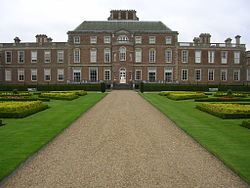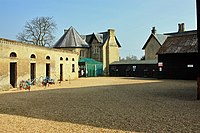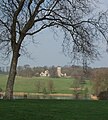Wimpole Hall: Difference between revisions
mNo edit summary |
mNo edit summary |
||
| Line 9: | Line 9: | ||
|website={{NT link}} | |website={{NT link}} | ||
}} | }} | ||
'''Wimpole Hall''' is a seventeenth century country house located within the | '''Wimpole Hall''' is a seventeenth-century country house located within the parish of [[Wimpole]] in southern [[Cambridgeshire]], north of [[Royston, Hertfordshire|Royston]] and about 8½ miles south-west of [[Cambridge]]. The house and its 3,000 acres of parkland and farmland are owned by the [[National Trust for Places of Historic Interest or Natural Beauty|National Trust]] and are regularly open to the public. | ||
Wimpole is the largest house in Cambridgeshire. Over the centuries, many notable architects have worked on it, including its first owner, Thomas Chicheley (between 1640 and 1670), James Gibbs (between 1713 and 1730), James Thornhill (1721), Henry Flitcroft (around 1749), John Soane (1790s), and H. E. Kendall (1840s). | Wimpole is the largest house in Cambridgeshire. Over the centuries, many notable architects have worked on it, including its first owner, Thomas Chicheley (between 1640 and 1670), James Gibbs (between 1713 and 1730), James Thornhill (1721), Henry Flitcroft (around 1749), John Soane (1790s), and H. E. Kendall (1840s). | ||
Latest revision as of 14:59, 24 November 2020
| Wimpole Hall | |
|
National Trust | |
|---|---|
 Wimpole Hall | |
| Grid reference: | TL336510 |
| Information | |
| Website: | Wimpole Hall |
Wimpole Hall is a seventeenth-century country house located within the parish of Wimpole in southern Cambridgeshire, north of Royston and about 8½ miles south-west of Cambridge. The house and its 3,000 acres of parkland and farmland are owned by the National Trust and are regularly open to the public.
Wimpole is the largest house in Cambridgeshire. Over the centuries, many notable architects have worked on it, including its first owner, Thomas Chicheley (between 1640 and 1670), James Gibbs (between 1713 and 1730), James Thornhill (1721), Henry Flitcroft (around 1749), John Soane (1790s), and H. E. Kendall (1840s).
History
Before the present Wimpole Hall was built in around 1640, there was a moated manor house set in a small deer park of 200 acres. To the north and south of this were three mediæval villages: Bennall End, Thresham End and Green End.
The hall has not remained in one family for its whole time but has changed hands several times over the centuries. It was built in 1640 for Sir Thomas Chicheley (c.1613–1699), but passed in 1689 to Sir John Cutler Baronet (1607-1693), then after his death to his son in law, Charles Robartes, 2nd Earl of Radnor, by a marriage settlement, then to Sir John's nephew. In 1710 John Holles, Duke of Newcastle, acquired the hall, just a year before his death, and in 1739 it came to Philip Yorke, 1st Earl of Hardwicke, and remained with the Earls of Hardwick until 1894, when it was acquired by Thomas Charles Agar-Robartes, 6th Viscount Clifden. Captain and Mrs George Bambridge left Wimpole Hall to the National Trust in 1976.
The parkland
Wimpole Hall's grounds were laid out and modified by landscape designers such as George London and Henry Wise (1693–1705), Charles Bridgeman (1720s), Robert Greening (1740s), Lancelot 'Capability' Brown (1767), and Humphry Repton (1801–1809). The parkland as it exists today is an overlay of the work of these landscape designers and gardeners, and was completed under the auspices of Elsie and George Bambridge. Elsie, the daughter of Rudyard Kipling, revitalised the house. Thanks to her efforts, this National Trust property is in the state it is in today.
Bridgeman's formal grand avenue sweeps away from the south front of the house for two and a half miles in contrast with the remainder of the park which was "naturalised" by Capability Brown. The North Park is particularly attractive with its belts of woodland, gentle rolling hills with individual trees and clumps of trees. The central feature of the North Park is the Gothic Tower and the restored lakes in the valley below.
In the grounds are a chain of lakes (1695–1767), a church (1749), St Andrew's, a folly (the false Gothic Tower; 1768), a farm (1792), a walled garden (18th century), and a stable block (1851).
Wimpole Home Farm

Wimpole Home Farm is an 18th-century model farm located at Wimpole Hall operated by the National Trust. It is one of 16 Rare Breeds Survival Trust approved farm parks.
Originally built in 1794 as a model farm by Sir John Soane for Philip Yorke, 3rd Earl of Hardwicke, the farm today displays a collection of farm implements and is home to a number of rare breeds of farm animals.
-
Wimpole the entrance front
-
Wimpole Hall in 1880
-
Wimpole's Folly, built in the 1700s to resemble Gothic-era ruins
-
The lake and Gothic folly in the grounds of Wimpole Hall
-
Wimpole the stable block
-
Wimpole glasshouses in the kitchen garden
Outside links
| ("Wikimedia Commons" has material about Wimpole Hall) |
- Wimpole Estate - National Trust
- Welcome to Wimpole
- Gardens Guide information
- Wimpole Estate parkrun






